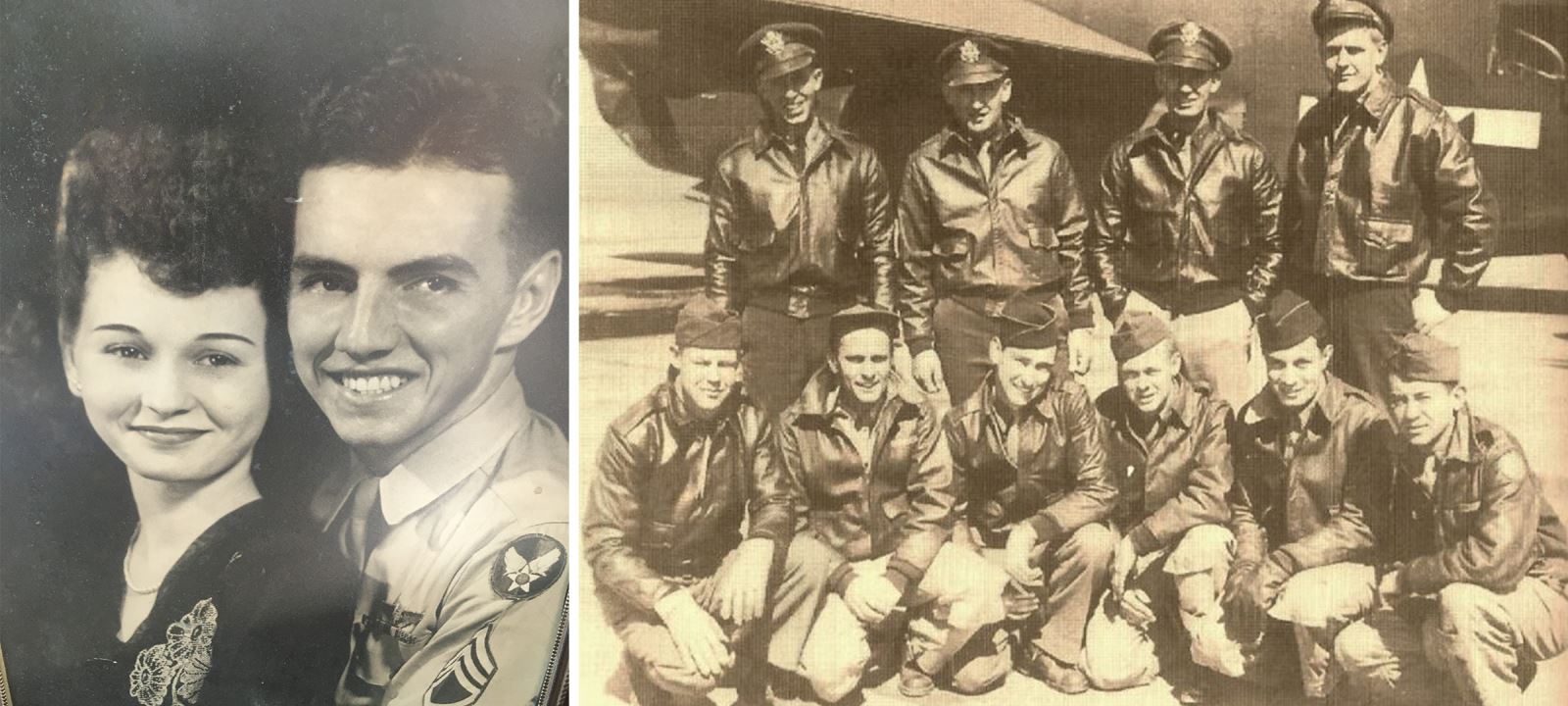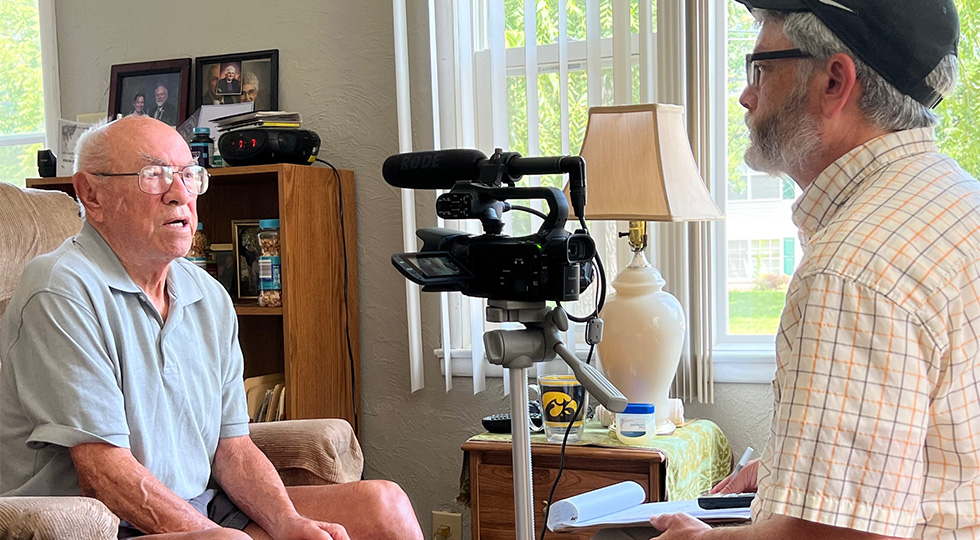Downed Iowa airman, 99, saved by French in WWII
Posted
by Pat Kinney
on Friday, August 12, 2022
CEDAR RAPIDS - Mike Bisek had an extended tour of the mountains of southern France 78 years ago this month. But it was hardly a vacation.
Bisek, now 99 and a lifetime resident of Cedar Rapids, was a U.S. Army Air Force aerial photographer on a B-24 Liberator bomber during World War II. The plane was shot down over Nazi-occupied southern France July 19, 1944 after an air raid on Munich, Germany rail yards. They were protected and concealed by French Resistance underground fighters. They through mountainous terrain and over a glacier in the French Alps. They linked up with Free French regular army and American troops near Grenoble, France 37 days later.
Grenoble was liberated Aug. 22, 1944. Bisek and all 10 crewmen of the B-24 survived. He told his story in a recent oral history interview with the Grout Museum District.
Bisek, who will turn 100 next April, is retired from Iowa Manufacturing in Cedar Rapids. He was part of the 460th Bombardment Group. He was based in liberated Spinazzola, Italy. He flew in 22 combat missions on various aircraft in the group, photographing bombardment targets and also serving as a backup aerial gunner.
The loss of aircraft in the groups on those missions was high, Bisek said.
"It wasn't uncommon to lose half of them," Bisek said. "You never knew when you went up there how you were going to make out." Their targets included oil refineries and factories and included close contact with enemy fighter places as well as antiaircraft fire.
"At that time I was really gung ho," he said. "I was 19 when I enlisted. I looked forward to it but I was scared too. I knew the risk was bad, but somebody had to do it."
On what would be his final mission, he was assigned to a B-24 commanded by Kennon "Ken" Sorgenfrei of Seattle. The crew had flown on twice as many missions as Bisek and was slated to go home.
"I wasn't always the most popular guy, because some guys were kind of superstitious" about taking on another crew member, Bisek said - especially a photographer. But he was familiar with many on Sorgenfrei's crew because they had played softball together.
When three of the aircraft's four engines went out in succession due to mechanical failure or enemy fire, Bisek and the crew had to bail out.
"Our gas line had been hit," Bisek recalled. "The plane was just soaked with gas. If a fighter had come up and shot a bullet, the plane would have exploded. Gas was coming in the window; I could smell it." Sorgenfrei ordered the crew to pitch containers of .50 caliber machine gun ammunition and his aerial camera in a vain attempt to keep the plane airborne. "We went until we ran out of gas. The plane was going down, so we bailed out."
Bisek said he could see the plane crash below as he parachuted to the ground. "It was just one big explosion," he said. A propeller from the plane was recovered by local townspeople and made part of a memorial which stands to this day.
Some French youth who came upon Bisek and another crewman after they'd parachuted into a farm field initially thought they were enemy and said "Boche! Boche!" the word for "German," But Bisek said, "No, American!" They youth alerted an adult with the resistance forces, which also rounded up other members of the crew. Many of the resistance fighters held civilian jobs during the day and fought at night.
Bisek said he and the B-24 crewmen had a price on their heads; the Nazis offered a cash reward for their capture. Because the Americans stood out among the local citizens in their unforms, they donned civilian clothes to avoid the Germans.
The French took on considerable risk in hiding the crewmen. Bisek recalled one resistance leader they had met was executed by the Germans on his way to his day job.

Image captions: Mike Bisek and fiance Myron Moore area show here in their engagement photo. They met while Bisek was recuperatin Biloxi Miss. after being shot down over occupied France during World War II.
Ken Sorgenfrei (top row, upper left) and his crew here, along with aerial photographer Mike Bisek of Cedar Rapids, were shot down over occupied France in July 1944 after a bombing raid over Munich, Germany. Bisek and the entire crew survived and avoided capture by the Nazis, having been concealed by French resistance fighters.The resistance fighters also engaged in firefights with the Germans as they concealed the American fliers. Bisek said the French would not let the Americans to engage in the fighting, but allowed them to tend to wounded partisans, some of whom were severely injured and had lost limbs in combat.
Bisek said the crew was officially pronounced as "missing in action" after being shot down. He said his mother back home in Cedar Rapids hung out a gold star at their home, thinking her son had been killed.
But American airborne troops who had landed as part of the Allied invasion of southern France learned through radio communications with the resistance that Bisek and his fellow airmen were alive. The resistance fighters broke through to the Free French regular army and American forces.
But Bisek was in no condition to enjoy liberation. In a freak accident, he had been shot through one knee as the Americans and resistance fighters passed a captured German Luger pistol as a souvenir. He was taken to a military hospital in Naples, Italy and then to Biloxi, Miss.
It was a fortuitous turn of fate for Bisek. That's where he met his wife Myron, or "Myra," who was working at Keesler Field Army Air Corps Base in Biloxi. They wed Oct. 6, 1945 and were married 66 1/2, years; she passed away in 2012.

Image caption: World War II veteran Mike Bisek, 99, is interviewed by Grout Museum District oral historian Pat Kinney at Bisek's home in Cedar Rapids. (Photo courtesy of Ron DeChristopher)
Bisek's friend and former Iowa Manufacturing colleague, Vietnam-era Army veteran Dick Pohorsky, is trying to get Bisek awarded a Purple Heart for his knee wound. Among his other decorations is the French Legion of Honor, France's highest civilian or military honor given the entire B-24 crew.
In the 1980s, Bisek was invited to join other members of what became known as the "Sorgenfrei crew" for a reunion in France with their rescuers. One of them was Pierre Montaz, a 19-year old resistance fighter at the time they were shot down, who later became a prominent manufacturer of ski lift equipment in Grenoble, the site of the 1968 Winter Olympics. Montaz wrote a book, "Eleven Americans Came from the Sky," chronicling the "Sorgenfrei Crew's" ordeal, rescue, and liberation. It has been translated into English and its foreword was written by Pierre Salinger, an American journalist working in France who became press secretary to President John F. Kennedy and worked for ABC News.
Pierre Montaz passed away Aug. 3, 2021 at age 97 from complications following an auto accident. Mike Bisek is the only one of the "Sorgenfrei crew" B-24 still living; Ken Sorgenfrei passed away in 2016. Pohorsky contacted the Grout Museum because he felt it was important to record Bisek's story for posterity.
The Grout has more than 2,000 video recorded oral histories of Iowa veterans of all eras and branches of service. They are frequently used in museum exhibits and may be viewed at the museum library and online.
To request an interview, contact the Museum at (319) 234-6357, or historian Bob Neymeyer at Bob.Neymeyer@gmdistrict.org or oral historian Pat Kinney at Pat.Kinney@gmdistrict.org.
More of Mike Bisek's story and the quest of for Purple Heart for him is recounted by freelance writer Cindy Hadish in her online Homegrown Iowan column at homegrowniowan.com.